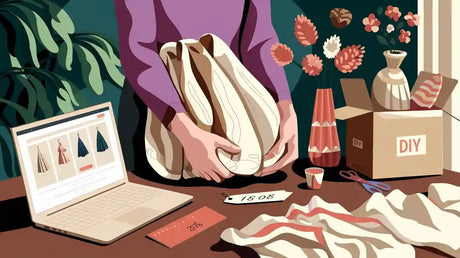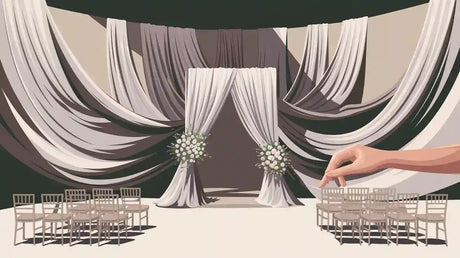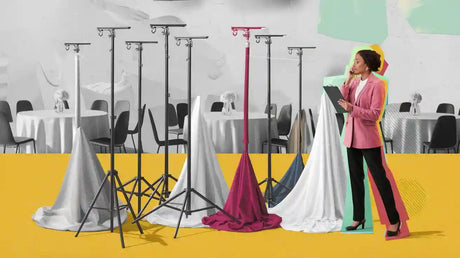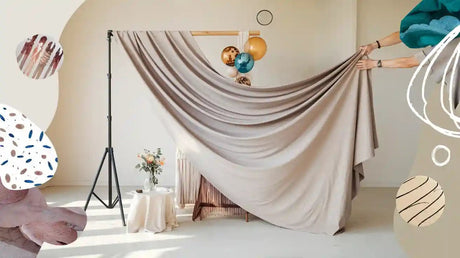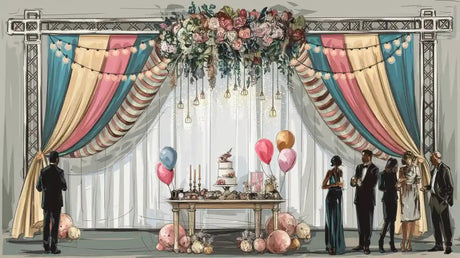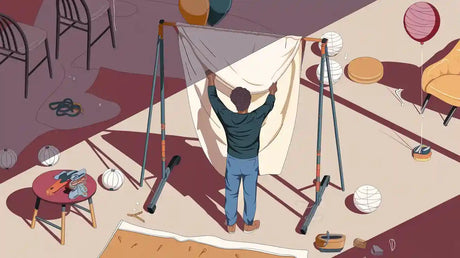Choosing the right fabric for round table linens depends on your needs and preferences. Cotton remains a popular choice, holding 35.7% of the market share due to its softness and versatility. Artificial fibers, including polyester, are growing at a rate of 4.9% annually, offering durability and easy maintenance. Specialty fabrics like linen silk add elegance to formal settings.
|
Fabric Type |
Market Share (%) |
Growth Rate (CAGR) |
|---|---|---|
|
Cotton |
35.7 |
N/A |
|
Artificial Fibers |
N/A |
4.9 |
|
Linen Silk |
N/A |
N/A |
When selecting table linens, consider factors like fiber content, laundering capabilities, and the environment. For example, natural fibers like cotton provide breathability, while synthetic options resist stains and wrinkles.
Key Takeaways
-
Cotton is soft and airy, great for everyday meals. But it wrinkles fast and might need lots of ironing.
-
Polyester is strong and easy to care for, ideal for big events. It doesn’t wrinkle much and keeps its color well.
-
Linen looks fancy for formal events and gets softer after washing. It needs extra care and costs more than other fabrics.
-
Satin tablecloths look fancy but need gentle care to avoid damage. They work best for high-class events.
-
Think about the event and table size when picking fabric. Choosing the right fabric makes the event feel special.
Top Fabric Options for Round Table Linens
Cotton
Benefits of Cotton
Cotton is a natural fiber known for its softness and breathability. It feels comfortable to the touch and adds a cozy charm to your table setting. Cotton tablecloths are highly absorbent, making them ideal for casual dining or family gatherings. They are also versatile and available in various colors and patterns, allowing you to match them with different themes.
Drawbacks of Cotton
While cotton offers many advantages, it does have some downsides. Cotton tablecloths wrinkle easily, requiring frequent ironing to maintain a neat appearance. They can also shrink if not washed properly. Additionally, cotton is less stain-resistant compared to synthetic fabrics, which may lead to permanent marks from spills.
Best Uses for Cotton Table Linens
Cotton tablecloths work best for everyday use or informal events. They are perfect for family dinners, picnics, or casual brunches. If you prioritize comfort and a natural look, a cotton tablecloth is an excellent choice.
Linen
Benefits of Linen
Linen tablecloths exude elegance and sophistication. This fabric is highly durable and becomes softer with each wash. Linen is also eco-friendly, as it is made from flax fibers. Its natural texture and slight sheen make it a popular choice for formal occasions.
Drawbacks of Linen
Linen requires more care than other fabrics. It wrinkles easily and may need professional cleaning for stubborn stains. Linen tablecloths can also be more expensive, which might not suit every budget.
Best Uses for Linen Table Linens
Linen tablecloths are ideal for weddings, formal dinners, or upscale events. They add a touch of luxury to your table setting and pair beautifully with fine china and crystal.
Polyester
Benefits of Polyester
Polyester is one of the most practical tablecloth material types. It offers several advantages:
|
Advantage |
Description |
|---|---|
|
Affordability |
Polyester is budget-friendly, making it accessible for large-scale events or businesses needing many linens. |
|
Durability |
It withstands frequent use and washing without losing integrity, ensuring longevity. |
|
Wrinkle Resistance |
Maintains a smooth appearance without constant ironing, saving time for event organizers. |
|
Color Retention |
Retains vibrancy and richness over time, even after washing and sun exposure. |
|
Low Maintenance |
Can be machine washed and tumble dried, making it practical for busy environments. |
|
Versatility |
Suitable for various events and can be mixed with other accessories for unique table settings. |
Drawbacks of Polyester
Polyester tablecloths lack the natural feel of cotton or linen. They may appear less luxurious in high-end settings. Additionally, polyester can sometimes retain odors if not washed thoroughly.
Best Uses for Polyester Table Linens
Polyester tablecloths are perfect for large events, such as banquets, conferences, or birthday parties. They are also a great option for restaurants or catering businesses due to their durability and low maintenance.
Satin
Benefits of Satin
Satin tablecloths bring a polished and high-quality look to your table settings. The fabric’s smooth, glossy surface reflects light beautifully, creating a luxurious ambiance. This makes satin an excellent choice for upscale events. Its sleek design ensures an unbroken flow of fabric, giving your tables a clean and sophisticated appearance. For instance, using a satin tablecloth in Ivory can transform an ordinary table into a stunning focal point. Satin also comes in a variety of colors, allowing you to match it with your event’s theme effortlessly.
Drawbacks of Satin
While satin offers undeniable elegance, it has some limitations. The fabric is more delicate compared to other tablecloth material types, making it prone to snags and tears. Satin also requires careful handling during cleaning. Machine washing can damage its glossy finish, so hand washing or dry cleaning is often necessary. Additionally, satin tablecloths can be slippery, which may cause items on the table to shift. Cost is another factor to consider. Satin is generally more affordable than polyester, with prices ranging from $0.79 to $1.49 per piece, but it may not be as durable.
|
Fabric Type |
Price Range |
|---|---|
|
Satin |
|
|
Polyester |
~$4.00 |
Best Uses for Satin Table Linens
Satin tablecloths are perfect for weddings, galas, and other formal events. They add a touch of glamour and sophistication to your table settings. Use satin when you want to create a luxurious atmosphere that leaves a lasting impression on your guests. Pair it with elegant centerpieces and fine dinnerware for the best results.
Specialty Fabrics (Velvet and Spandex)
Benefits of Velvet and Spandex
Velvet and spandex offer unique advantages for tablecloths. Velvet provides a rich texture and a plush appearance, making it ideal for creating a warm and inviting atmosphere. Its soft surface adds depth and dimension to your table settings. Spandex, on the other hand, is highly stretchable and fits snugly over round tables. This ensures a wrinkle-free and modern look. Spandex tablecloths are also lightweight and easy to transport, making them a practical choice for events.
Drawbacks of Velvet and Spandex
Velvet’s luxurious feel comes with a higher price tag. It is also heavier than other fabrics, which can make it challenging to handle. Cleaning velvet requires special care, as it is prone to stains and watermarks. Spandex, while convenient, lacks the elegance of velvet or satin. Its stretchy nature may not suit formal events. Additionally, spandex tablecloths are limited in design options, often available in solid colors only.
Best Uses for Velvet and Spandex Table Linens
Velvet tablecloths work best for intimate gatherings, holiday dinners, or events where you want to create a cozy yet elegant vibe. Spandex tablecloths are ideal for trade shows, corporate events, or modern-themed parties. They provide a sleek and professional appearance, especially when paired with minimalist decor.
Factors to Consider When Choosing a Fabric
Durability
When selecting the best material for tablecloths, durability plays a crucial role. You want a fabric that can withstand repeated use without losing its quality. Satin, for example, is not only luxurious but also durable. The Lamour Satin 108" Round Tablecloth demonstrates how satin combines strength with a silk-like texture, making it a reliable choice for both elegance and longevity. Polyester is another excellent option due to its resilience. It resists wear and tear, ensuring your tablecloths last through multiple events. If you prefer natural fibers, cotton offers decent durability, though it may require more care to maintain its appearance over time.
Maintenance and Cleaning
Ease of maintenance can save you time and effort, especially if you frequently use tablecloths. To keep your linens in top condition, follow these best practices:
-
Avoid overloading the washer to ensure proper cleaning.
-
Use the correct amount of detergent based on the load size and soil level.
-
Handle tough stains, like grease, with care. Bleach can help, but only if the fabric allows it.
-
Skip fabric softeners, as they can coat the material and make stain removal harder.
-
Wash similar colors together to prevent color transfer.
-
For new linens, such as Checkpoint™ fabrics, wash them separately during the first cycle to avoid bleeding.
Cotton tablecloths and linen tablecloths may require extra attention. Both fabrics wrinkle easily and may need ironing. Polyester, on the other hand, is low-maintenance and resists wrinkles, making it a practical choice for busy households or events.
Occasion and Aesthetic Appeal
The occasion often dictates the fabric for tablecloths. For weddings or formal events, satin and chiffon are popular choices. Satin’s glossy finish adds elegance, while chiffon’s lightweight and sheer quality create a romantic atmosphere. Linen tablecloths work well for upscale dinners, offering a sophisticated look with their natural texture. For rustic or minimalist themes, cotton provides a versatile and breathable option. Polyester suits casual gatherings or large-scale events, where practicality and cost-effectiveness matter most.
When choosing the best tablecloth material, consider how the fabric complements your event’s theme. A satin tablecloth can elevate a wedding reception, while a cotton tablecloth adds charm to a family brunch. Matching the fabric to the occasion ensures your table settings leave a lasting impression.
Budget and Cost-Effectiveness
When choosing the best material for tablecloths, budget plays a significant role. You want to balance cost with quality to ensure your investment meets your needs. Renting tablecloths may seem convenient, but it often costs more in the long run. For example, renting 50 linens at $24.95 each totals $1,247.50. Buying the same number costs $839 upfront, with an additional $575 for cleaning. Even with these extra expenses, purchasing tablecloths can save you money over time, especially if you plan to reuse them.
|
Option |
Cost per Linen |
Total for 50 Linens |
Additional Costs |
Net Cost After Resale |
|---|---|---|---|---|
|
Renting |
$24.95 |
$1,247.50 |
N/A |
N/A |
|
Buying |
$16.78 |
$839 |
$575 (cleaning) |
$1,030 |
The type of fabric also affects cost-effectiveness. Polyester stands out as a highly affordable option. It offers durability, wrinkle resistance, and easy maintenance, making it ideal for busy settings or large events. Cotton, while slightly more expensive, provides a soft and classic look suitable for both formal and casual occasions. If you want a premium option, Milliken Signature fabric combines elegance with durability, offering excellent value for its price.
|
Fabric Type |
Description |
Cost-Effectiveness |
|---|---|---|
|
Cotton |
Soft and classic, suitable for formal and casual events. |
Moderate |
|
Polyester |
Durable, wrinkle-resistant, and easy to care for, ideal for busy settings. |
High |
|
Milliken Signature |
High-quality fabric known for its elegance and durability. |
High |
To make the most of your budget, consider your event's scale and frequency. For one-time events, renting might work better. However, if you host events regularly, buying tablecloths offers better long-term savings. Polyester is often the best tablecloth material for cost-conscious buyers, while cotton provides a balance between affordability and style. By evaluating your needs and comparing options, you can find the best material for tablecloths without overspending.
Practical Tips for Selecting the Right Fabric

Match the Fabric to the Event
Choosing the right fabric for tablecloths starts with understanding the event's tone and purpose. For formal occasions like weddings or galas, satin or organza works beautifully. Satin’s glossy finish adds elegance, while organza’s crisp texture creates a layered, sophisticated look. For casual gatherings, cotton offers a breathable and versatile option that suits both indoor and outdoor settings.
Here’s a quick guide to help you match fabrics to events:
|
Fabric Type |
Characteristics |
Ideal Uses |
|---|---|---|
|
Chiffon |
Lightweight, sheer, adds soft elegance |
Romantic backdrops, draping ceilings |
|
Satin |
Smooth, glossy finish, luxurious appearance |
Formal events, elegant backdrops |
|
Cotton |
Breathable, durable, versatile for indoor and outdoor settings |
Rustic weddings, minimalist backdrops |
By aligning the fabric with the event’s theme, you ensure your table settings enhance the overall atmosphere.
Consider the Table Size and Shape
The size and shape of your table significantly influence your choice of fabric for tablecloths. Start by measuring the table’s dimensions, including its length, width, or diameter. Add twice the desired drop length to these measurements to determine the correct tablecloth size. For example, a round table with a 60-inch diameter and a 15-inch drop requires a tablecloth with a 90-inch diameter.
-
Ensure the tablecloth dimensions match the table’s size and shape for a proper fit.
-
Choose different styles of linens based on the table’s shape. For instance, spandex works well for round tables, while rectangular tables benefit from tailored edges.
-
Consider the drop length. A longer drop suits formal events, while a shorter one works for casual settings.
Matching the tablecloth to the table’s size and shape ensures a polished and professional look.
Balance Style with Practicality
Balancing style and practicality is essential when selecting fabric for tablecloths. Cotton provides a soft, eco-friendly option but may wrinkle easily. Polyester offers durability and wrinkle resistance, making it ideal for busy environments. For a blend of style and functionality, consider cotton/polyester blends. These combine the softness of cotton with the strength of polyester.
|
Material Type |
Advantages |
Disadvantages |
|---|---|---|
|
Cotton |
Soft feel, absorbent, breathable |
Susceptible to wear, wrinkling, staining |
|
Polyester |
Durable, wrinkle-resistant, color-fast |
May lack the softness of cotton |
|
Cotton/Polyester Blend |
Combines softness and strength |
N/A |
When choosing, think about the event’s demands. For example, polyester suits large-scale events due to its low maintenance, while cotton works better for intimate gatherings. By evaluating your needs, you can strike the perfect balance between aesthetics and functionality.
Test for Quality Before Buying
Before purchasing table linens, testing their quality ensures you get the best value for your money. High-quality fabrics not only look better but also last longer. Here are some practical methods to help you identify premium table linens:
-
Check the Price Point: Genuine linen often costs more due to its labor-intensive production process. If the price seems unusually low, the fabric might not be authentic.
-
Examine Yarn Thickness: Look closely at the fabric. Subtle variations in yarn thickness often indicate natural fibers, which are a hallmark of high-quality linen.
-
Feel the Wrinkles: Wrinkles are not a flaw but a natural characteristic of linen. If the fabric wrinkles easily, it is likely made from authentic fibers.
-
Test Flexibility: Bend and handle the fabric. Genuine linen softens with use, unlike synthetic materials that may feel stiff over time.
-
Look for Slubs: Tiny knots or irregularities, known as slubs, are signs of unprocessed and durable linen.
-
Perform a Light Test: Hold the fabric up to the light. High-quality linen has a balanced opacity, neither too sheer nor too dense.
-
Try the Moisture Test: Place a drop of water on the fabric. Quality linen absorbs moisture quickly and feels cool to the touch.
-
Assess Resilience: Gently pull and release the fabric. Authentic linen should stretch slightly and bounce back, showing its durability.
-
Research the Source: Knowing where the fabric comes from can provide insight into its quality. Reputable manufacturers often produce better linens.
-
Conduct a Burn Test: If possible, burn a small piece of the fabric. Genuine linen produces a herbaceous scent and leaves behind powdery ash.
Additionally, keep an eye out for common indicators of high-quality fabrics:
-
Look for slubs, as they signify authenticity and durability.
-
Check for natural stretch and recoil, which reflect craftsmanship.
-
Ensure the fabric absorbs moisture quickly without feeling damp.
By following these steps, you can confidently select table linens that combine beauty, durability, and value. Quality testing helps you avoid disappointment and ensures your linens enhance your table settings for years to come.
Choosing the best fabric for round table linens depends on your needs and the event’s purpose. Cotton and linen provide a natural look and feel, perfect for formal or casual gatherings. Polyester offers durability and easy maintenance, making it ideal for everyday use. Satin adds elegance to upscale events, while specialty fabrics like velvet and spandex create unique aesthetics. Consider the material, size, and care requirements to find the best tablecloth material for your occasion. Matching the fabric to the event ensures both style and practicality, helping you create memorable table settings.
FAQ
What is the easiest fabric to maintain for table linens?
Polyester is the easiest fabric to maintain. It resists wrinkles, stains, and fading, making it ideal for frequent use. You can machine wash and tumble dry it without worrying about damage. This makes it a practical choice for busy households or large events.
How do I choose the right size tablecloth for a round table?
Measure the table’s diameter and add twice the desired drop length. For example, a 60-inch table with a 15-inch drop needs a 90-inch tablecloth. Always ensure the tablecloth fully covers the table for a polished look.
Are natural fabrics better than synthetic ones for table linens?
Natural fabrics like cotton and linen offer breathability and a classic look. Synthetic fabrics like polyester provide durability and easy maintenance. Your choice depends on your priorities—natural for elegance or synthetic for practicality.
Can I use satin tablecloths for outdoor events?
Satin works best for indoor events. Its delicate surface can snag or stain easily outdoors. For outdoor settings, consider polyester or cotton, which handle wear and tear better while maintaining a stylish appearance.
How do I remove tough stains from table linens?
Treat stains immediately. Use a mild detergent or stain remover suitable for the fabric. For natural fibers like cotton or linen, avoid bleach unless the label permits it. Always follow the care instructions to prevent damage.

